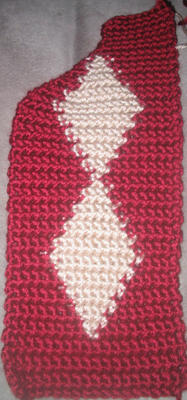 Not sure how well it comes across in the photo, but the colors I am using are autumn red and bone (which is a very pale, almost metallic, tan), both Caron's Simply Soft. I am a long-time fan of autumn red, and the bone goes surprisingly well with it. I'm not sure yet if I'm going to go ahead with the embroidery that's supposed to criss-cross it; depends on whether I can find a third color I think works well. Dark brown, perhaps. Nothing I currently have on hand or could find at Wal-Mart tonight.
Not sure how well it comes across in the photo, but the colors I am using are autumn red and bone (which is a very pale, almost metallic, tan), both Caron's Simply Soft. I am a long-time fan of autumn red, and the bone goes surprisingly well with it. I'm not sure yet if I'm going to go ahead with the embroidery that's supposed to criss-cross it; depends on whether I can find a third color I think works well. Dark brown, perhaps. Nothing I currently have on hand or could find at Wal-Mart tonight.This wasn't very hard to do. I didn't wind mini-balls this time. Since I'm just using two colors and since the diamonds go up the center, I just carried the red along behind the bone at the necessary times. Loosely. I think it turned out rather well.
One bit of advice for anyone contemplating trying intarsia for the first time: know how, when you change colors normally, you work off all but the last two loops, then switch to the new color to complete the stitch? Be certain to do that here the stitch before you need to switch colors. This may be obvious to someone smarter than I, but it took trial-and-error to become obvious to me, so I share it in hopes it can help someone else. It's not very clearly explained in the single paragraph Ms Jensen devotes to the topic in the back of the book.
Which leads me to another brief complaint about the book. There are six patterns, out of 25, that use this technique. The next most-common technique, a certain stitch/stripe pattern, has four patterns, so intarsia has 50% more patterns than the next most common technique. And this is the only explanation you get for the technique:
Intarsia
All the Argyle designs are worked with
separate bobbins of individual colors so
there are no long strands of yarn. When
changing color, pick up new color from
under dropped color to prevent holes.
All the Argyle designs are worked with
separate bobbins of individual colors so
there are no long strands of yarn. When
changing color, pick up new color from
under dropped color to prevent holes.
And that's it. Intarsia is not a common technique in crochet. To have such a relatively large portion of the book depend upon this technique and to give so little explanation for it...That's not a good thing.
Still, I'm mostly satisfied with the way this is going so far. It is coming along surprisingly fast. I did all of what is in the picture in an hour-and-a-half, and didn't have to frog it at all. So I should be done completely within the next few days, barring childbirth. ;-)
Still, I'm mostly satisfied with the way this is going so far. It is coming along surprisingly fast. I did all of what is in the picture in an hour-and-a-half, and didn't have to frog it at all. So I should be done completely within the next few days, barring childbirth. ;-)















1 comment:
Looking good. I just started working intarsia crochet recently. You're right, you must change colors by finishing off the stitch before the change in color is made. I don't use bobbins or little balls when working intarsia. I don't do it when knitting intarsia either. Call me lazy, but I've not had any problems with my method.
Looking good girlfriend!
Post a Comment